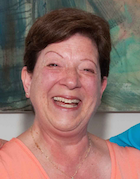How to Become an Inspirational Teacher
The Inspirational Teacher, 2nd Edition
By Gary McGuey and Lonnie Moore
(Routledge/Eye on Education, 2016 – Learn more)
When choosing a book to review for MiddleWeb, I was immediately drawn to this title: The Inspirational Teacher. What teacher, whether stepping into the classroom for the very first time or well into the journey, doesn’t want to inspire the many students encountered during a career?
I was expecting a collection of teaching tales and wise advice that would make me reflect on my own career and perhaps provide me with some things to share with the pre- and in-service teachers I often work with through the National Writing Project at Rider University.

The publisher’s introduction to the book promises a text that will “guide you through a simple four-step process to building high-trust relationships and unleashing the greatness within all students.”
I began with a skeptical eye
It was this “four-step process” that bothered me before and during my initial reading of the book, as I felt as though I was reading the authors’ very polished training workshop script. How does one become an inspirational teacher in four easy steps?
But as I continued to read, I discovered that in spite of the prescriptive nature of the text, it was making a great deal of sense about the importance of building relationships with students, parents, colleagues, and community. And yes, there are times when a structure – a “to-do” list of sorts – can be reassuring and useful to a teacher. I am thinking in particular of those new to the profession. With all of the mandates and must-do’s facing teachers, a book like this can be of value.
It’s a quick, well-organized read
The book is 99 pages in length and written clearly and concisely with numerous bulleted lists, inspirational quotes, and vignettes of inspirational teaching sprinkled liberally throughout the text. Each chapter of the book ends with a brief summary and chapter reflection questions. Questionnaires and other charts linked to chapter content also appear throughout the book.
Part One, “The Foundation of the Inspirational Teacher,” is divided into three chapters: Introduction, The Personal Mission Statement, and The Classroom/Grade-Level Mission Statement. The creation of both a personal and a classroom/grade level mission statement is preceded by a clear discussion of the challenges facing teachers today, including: How has the role of the teacher changed? What are these roles? Why do you teach? Are you a professional educator, or do you have a job? (p. 8)
As the authors consider these and other questions, their belief in the necessity of having a personal mission statement (they provide numerous examples) is clearly the foundation for the rest of the book. Guidelines for creating both personal and classroom statements are provided by the authors:
“A great mission statement should:
Inspire you.
Present who you are and what principles you value.
Clarify what is important to you.” (p. 16)
The personal and classroom/grade level mission statements created in Part One now become the base of the pyramid used as a visual to describe the four steps to becoming an inspirational teacher (from the base of the pyramid to the top) in the first four chapters of Part Two: Modeling Principles, Demonstrating Respect, Genuine Listening, and Building High-Trust Relationships. A fifth chapter, Conclusion, ends the book.
Reading Part Two had me nodding my head in agreement with many statements and often alternated with a sense of either “Yes! I have done that” or “Wow! I should have done that more.”
The chapter on genuine listening particularly resonated with me, especially the description of the four listening styles: pretend listening, selective listening (listening while planning when to jump in with one’s own comment), listening to fix, and listening to feel. It was easy (and sometimes a little embarrassing) to see myself in each description. Learning to listen and learning what to say when – this book gives good advice.
Nancy Chodoroff is a retired educator who has enjoyed a varied teaching career. Starting as an elementary teacher, Nancy “graduated” to middle school where she taught reading and American history, and served as a master teacher before becoming her district’s first Literacy Coach. She also had the privilege of serving on a national Middle Level Task Force in Washington, DC, and as an adjunct professor in Rider University’s College of Education (Lawrenceville, NJ). Nancy continues to share her love of teaching through her current work with the National Writing Project chapter at Rider University.



































